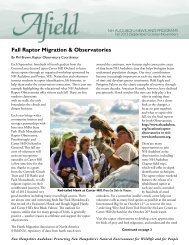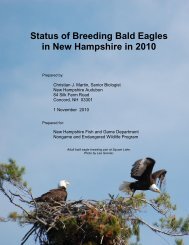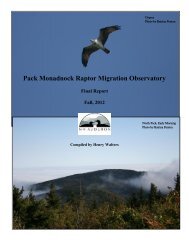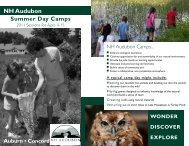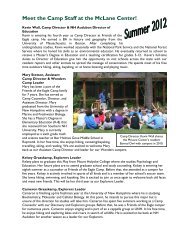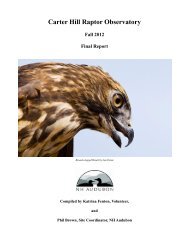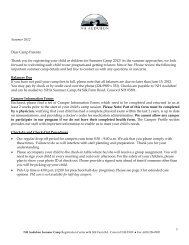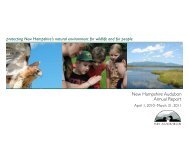The New Hampshire Dragonfly Survey: - New Hampshire Audubon
The New Hampshire Dragonfly Survey: - New Hampshire Audubon
The New Hampshire Dragonfly Survey: - New Hampshire Audubon
- No tags were found...
You also want an ePaper? Increase the reach of your titles
YUMPU automatically turns print PDFs into web optimized ePapers that Google loves.
DiscussionCompletion of the NHDs allows for evaluation of the project with respect to its three originalgoals:1) Obtain better information on the distribution and abundance of Odonata of potentialconservation concern in <strong>New</strong> <strong>Hampshire</strong>,2) Collect data from poorly surveyed parts of the state, and3) Increase public awareness of dragonfly diversity and conservation.In addition to these goals, the following sections will address future uses of NHDS data,and future survey needs in terms of habitats and/or regions of <strong>New</strong> <strong>Hampshire</strong>. An additional useof the NHDS data, and not one explicitly outlined at the project’s inception, is in scientificresearch. Already there is interest in this significant data set from researchers working oncommunity ecology, habitat modeling, and evolutionary genetics.ConservationHunt (2006) identified 56 species and three habitats (Rivers and Streams, SouthernPeatlands, and Northern Lakes/Peatlands) of potential conservation concern in a preliminaryconservation assessment of the Odonata of <strong>New</strong> <strong>Hampshire</strong>. Based on data collected during theNHDS, a significant majority of these species appear more common and/or widespread thanpreviously believed, with well over a thousand records of all but four of the 56 species. Perhapsonly 10-12 species from a smaller list of 26 highest priority species warrant carefulconsideration. A more detailed overview of NHDS coverage with respect to the three priorityhabitat groups is presented in the next section.It is not within the scope of this report to carefully evaluate NHDS data with respect tospecies S-ranks or listing status, but an immediate outcome of the project’s completion will be towork with the <strong>New</strong> <strong>Hampshire</strong> Natural Heritage Bureau to update S-ranks and revise theBureau’s list of tracked species. As part of this process, the list of species considered “specialconcern” in 2009 will be revisited with the NH Fish and Game Department. In addition, datafrom the NHDS will be used in a recently-initiated Northeast Region conservation assessmentbeing led by the <strong>New</strong> York Heritage Program and funded through a Northeast RegionalConservation Needs grant, with funds provided by State Wildlife Grants.From a conservation standpoint, it will be important to consider repeating the NHDS atsome point in the future, probably in the 20-30 year range. Current efforts have resulted in astrong baseline data set on Odonata distributions in the state, against which future changes – bethey due to climate change, habitat loss, or other factors – can be measured.<strong>Survey</strong> CoverageBy all measures, Goal 2 was met more successfully than ever imagined, and <strong>New</strong><strong>Hampshire</strong> is now one of the best surveyed states in the Northeast, if not the country. Aminimum of 115 species have been recorded in all ten counties, and data of some sort exist for244 of the state’s 259 towns. 37% of towns are known to contain a minimum of 50 species, and40



